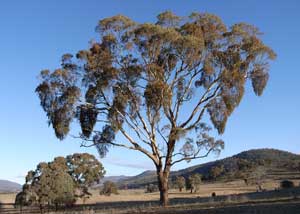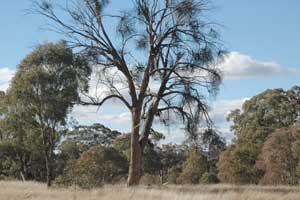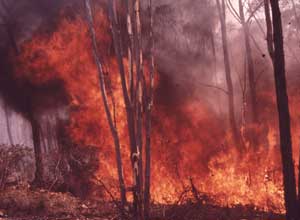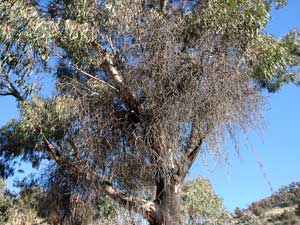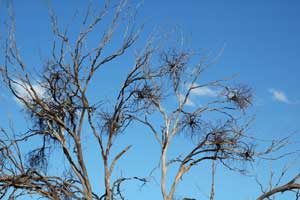|
Mistletoes and bushfires
One problem for the host tree in environments such as Australia is water conservation. As discussed earlier, eucalypts have evolved strategies to minimise water loss in times of drought. The 'breathing holes' or stomates on the eucalypt leaf surface close up when under water stress to reduce moisture loss. The mistletoes parasitising the tree have no such water saving strategies, leaving their stomates wide open like a tap draining the tree's valuable moisture by evaporation. When trees have only minor mistletoe infestations they can probably cope with this water loss, but a heavily infested tree is under far more stress than its neighbours in times of severe drought and the mistletoe is likely to be the tipping point in causing its death.
Fire on the other hand can be a great 'cleansing agent' for trees infested with mistletoes. Most eucalypts have developed strategies for regeneration after fire, especially from epicormic shoots that re-sprout from beneath the bark. A few years after the fire most eucalypts have re-gained their canopy of foliage. The mistletoes that infested them have no such fire resistance and are usually killed.
Fires are part of the natural cycle of the Australian bush and provided they are not too frequent they play an essential role in the 'health' of the natural forest. One of those roles is to stop mistletoes getting out of hand. But when the forest is partially cleared to create a landscape of scattered trees with grazing pasture beneath, we break the cycle of periodic fires reaching the canopy of those trees. It is in these landscapes that we often see the individual tree, isolated from crown fires, covered with an ever increasing load of mistletoes ![]() . The more mistletoe the more Mistletoe Birds, the more droppings, the more plants and the ever greater drain on the tree's water resources from all those open stomates. The skeletons of dead isloated eucalypts with signs of past heavy mistletoe infestation are a common sight in our semi-cleared landscape.
. The more mistletoe the more Mistletoe Birds, the more droppings, the more plants and the ever greater drain on the tree's water resources from all those open stomates. The skeletons of dead isloated eucalypts with signs of past heavy mistletoe infestation are a common sight in our semi-cleared landscape.
![An Australian Government Initiative [logo]](/images/austgovt_brown_90px.gif)


